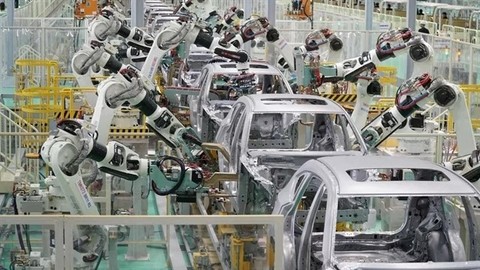
VN's auto sector is poised to become a competitive player in the global automotive industry in the years ahead. — Photo congthuong.vn
The domestic automobile industry is undergoing a significant transformation as it increasingly integrates into global markets and attracts foreign investment, according to automobile experts.
International automobile companies are establishing manufacturing and assembly plants in Việt Nam, enhancing the country’s production capabilities and reducing reliance on imports. This trend is expected to continue, with more foreign companies likely to invest in the years to come.
Since 2018, Việt Nam has benefitted from a zero per cent import tax on cars from ASEAN countries under the ASEAN Trade in Goods Agreement (ATIGA). While this has led to an influx of imported vehicles, it has also increased competition for local manufacturers. By 2030, tariff reductions for vehicles from Europe, Japan and Mexico are expected to intensify this competition.
In response to pressure from imported cars, the Vietnamese government has rolled out policies to stimulate the domestic automobile industry. These initiatives have already shown positive results, helping local manufacturers increase the production and sale of vehicles.
Export successes
Hyundai Thanh Cong Vietnam (HTMV) has been making strides in exporting Vietnamese-made vehicles, particularly Hyundai Palisade SUVs. In 2024, HTMV sent its fourth batch of Palisade units to Thailand, with plans to increase exports to Southeast Asia and other regions.
VinFast, the Vietnamese electric vehicle (EV) manufacturer, made waves by exporting its first batch of electric vehicles to the US in 2022. This milestone showcased the country’s growing reputation in the global automotive market, particularly in the EV sector.
Thaco, another major player, achieved over US$10 million in revenue from exporting 2,500 vehicles in 2023. This growth further underscores Việt Nam's appeal as an emerging automotive hub for global investors.
Strategic partnerships
Several joint ventures between global automakers and Vietnamese companies have been established. For example, the partnership between Tasco Joint Stock Company and Chinese Geely Auto Group will see the assembly of vehicles with a planned production capacity of 75,000 units annually.
Geleximco and Chinese Chery have partnered to introduce Omoda and Jaecoo car lines to the Vietnamese market, with an estimated $800 million investment in a new manufacturing facility.
Czechia’s Skoda Auto has chosen Việt Nam as the location for its first Southeast Asian assembly plant, marking a significant milestone for the region’s automotive sector.
TMT Motors is cooperating with the GM-SAIC-Wuling Joint Venture to focus on manufacturing and distributing electric vehicles (EVs), demonstrating the sector's increasing focus on green technologies.
Growth targets
The Vietnamese Government has set an ambitious goal for the automotive industry under its 'Strategy for Developing Việt Nam’s Automobile Industry to 2030'.
Targets under the strategy include a projected annual growth rate of 14-16 per cent for the domestic vehicle market through 2030, with sales reaching 1-1.1 million units per year.
By 2045, annual vehicle consumption is expected to rise to between five and 5.7 million units.
Meanwhile, production is set to grow to up to 700,000 vehicles annually by 2030, with 18-22 per cent being green vehicles. A localisation rate of 55-60 per cent is also expected for vehicle components and spare parts, signaling a push for domestic sourcing.
Despite facing challenges in meeting these ambitious targets, Việt Nam’s expanding network of free trade agreements provides an opportunity to enhance the competitiveness of the automotive sector. These agreements open access to key international markets and are crucial for the continued growth of the industry.
The Vietnamese automobile industry is at an exciting crossroads, marked by increasing foreign investments, strategic partnerships and a growing reputation in global markets.
With strong Government support, a focus on electric vehicles and ambitious growth plans, the sector is poised to become a competitive player in the global automotive industry in the years ahead. — VNS